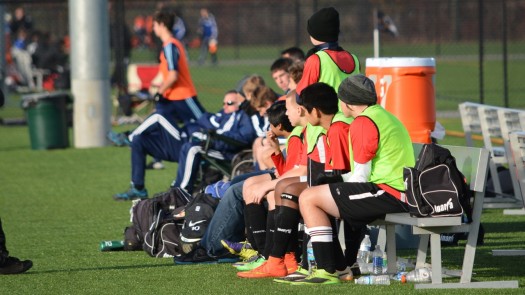Prevent cold-weather muscle strains: Five dos and don’ts
 The body is amazing in survival mode. Heat it up and it finds ways to dissipate the extra heat. Cool it down and it finds ways to retain the heat it has.
The body is amazing in survival mode. Heat it up and it finds ways to dissipate the extra heat. Cool it down and it finds ways to retain the heat it has.
But survival dictates that the most important parts, the brain and internal organs, are provided for even at the expense of the extremities. Unfortunately, on these very cold days, that’s not such good news for the muscles in the limbs we use to play soccer.
To maintain core temperature, blood vessels meant to supply the skin and muscles of the arms and legs constrict in order to keep our center warmer. The result is feet and hands that feel chilly or don’t feel much at all. Those cold muscles are ripe to be strained or pulled. If your mind says go when your hamstring says no, you may be in for some unscheduled injury time off.
+READ: Survival Training: Five healthy ways to tackle “icebreaker” tournaments
The key to protecting muscles from injury in the cold is convincing your survival mechanism not to go into survival mode. That’s tough when temperatures drop into the teens and twenties and the wind chill is lower yet. When practice is called or games are scheduled under those conditions, it’s time to take action.
Here are five dos and don’ts to keep those muscles at performance temperature:
Do: Layer Your Clothing
Wear compression shorts or compression leggings and shirts under your uniform gear.* That first layer should be in direct contact with the skin but made of a moisture-wicking fabric so that heat generated by exercise can be dissipated effectively. It will help retain some of the heat generated, but won’t hang onto sweat once you start getting warmed up.

Cotton t-shirts have the opposite effect. Once they’re wet, they hold the moisture against the skin and the second you stop running or are subbed out, you’re chilled to the bone. That’s a cold your muscles will regret.
Pre-game layers (inside to out): compression gear, uniform, outer insulating layer (including hat, where up to 50 percent of body heat generated can be dissipated)
Do: Give Warm-Up Extra Attention
Start slowly with an extra layer of clothing over your uniform. As soon as you start to feel warm, lose the outer layer. It’s a rookie mistake to wear heavy sweats under your uniform shorts, so they can’t be removed when you reach playing temperature.
+READ: A “female-friendly” soccer ball: Friend or Foe?
Increase pace and quickness of movement gradually, paying full attention to how your muscles feel. It takes a while for that warm up to reach tendons and joint tissues that need full lubrication to function well. Be sure to warm up your accelerations; you don’t want to leave that to chance when game hype jump-starts a cold muscle.
Pre-game warm up: extra slow, extra care, finish warm up with movement at game speed
Do: Perform a “Dynamic Stretch” Warm-up
Make sure that warm-up is more than a jog – sprint – go. The warmed-up body needs to move through full range of motion and gradually build to game demands. Keep it moving (so you keep warm) while you go through game stretches: Hamstrings, quads, calves, hips, ankles, arms and shoulders. Make sure the lubrication is good to go.
Do: Warm up to Game Conditions
The field is hard and perhaps slippery, and the ball will be the same. Warm up to the feel of the ball, the roll of the turf, and the ground under your feet. After your body is good and warm, run and cut and maneuver as you will when the game begins.
 A fully ready body is completely connected with the environment, the surface, the space and the game. When you’re waiting for the opening whistle, keep your body moving with steps, jumps or running in place so nothing surprises you when the ball comes your way.
A fully ready body is completely connected with the environment, the surface, the space and the game. When you’re waiting for the opening whistle, keep your body moving with steps, jumps or running in place so nothing surprises you when the ball comes your way.
Game time: movement feels fluid, response is on the mark, no surprises
Do: Stay Warm on the Bench and Warm Again Before Re-entering the Game
Grab a blanket, jacket, hat and gloves as you come out of the game and put them on once you start to cool from game play. I know some players don’t do this because they want to show coach their readiness to come back into play. I don’t buy it. If I want to sub a player in, I tell him at last 5 minutes before I want him ready so he can shed extra layers, and re-warm on the sidelines with movement at increasing pace and in all directions, including short sprints to re-warm the brain-to-muscle connection to game speed.
+READ: LeBolt: Youth teams getting it right in pregame warm-ups, but still work to be done
**Coaches: alerting players to give them re-warming time is critical for injury prevention and peak performance from your sub. This is simply smart soccer and our responsibility.
Resting and return to game: Gradually cool, then re-warm to return to play
Don’t:
- Stand still on the pitch waiting for the ball to come. Goalkeepers, this means you, too!
- Blow on your hands to stay warm. (After a quick burst of heat, the water vapor from your breath can leave hands feeling colder.)
 Arrive late for warm-ups and hurry your preparation.
Arrive late for warm-ups and hurry your preparation.- Don’t ever stretch cold muscles!
- Assume that muscle will go 0-60 like it does on a temperate day. Test it to be sure.
I heard that teams competed in tournament play in driving snow and 50-mph wind gusts a couple weeks ago. Funny, there was not much scoring in those games. Are you kidding me? Hey, even if you paid your money for four guaranteed games and the fields are open, why are we playing these games? Sometimes, the best science and common sense says, call it a day and re-schedule.
*FIFA says clothing that shows under your uniform must be the same color as that piece of your uniform.
SOCCERWIRE MARKETPLACE
- Adidas National Cup 2026
- Adidas Showcase 2025
- Adidas Preseason Clash 2025
- Capital Fall Classic 2025 - Register by October 1st
- Applications are Now Open for the 2026 Jefferson Cup
- Start the Season Strong at Loudoun Premier Cup!
- 50th Annual Rael Vodicka Memorial Tournament
- Soccer Marketing Internships at The St. James FC
- Job Opening: The St. James FC Goalkeeper Academy Coach
- Full-Time Director of Goalkeeping for The St. James FC











